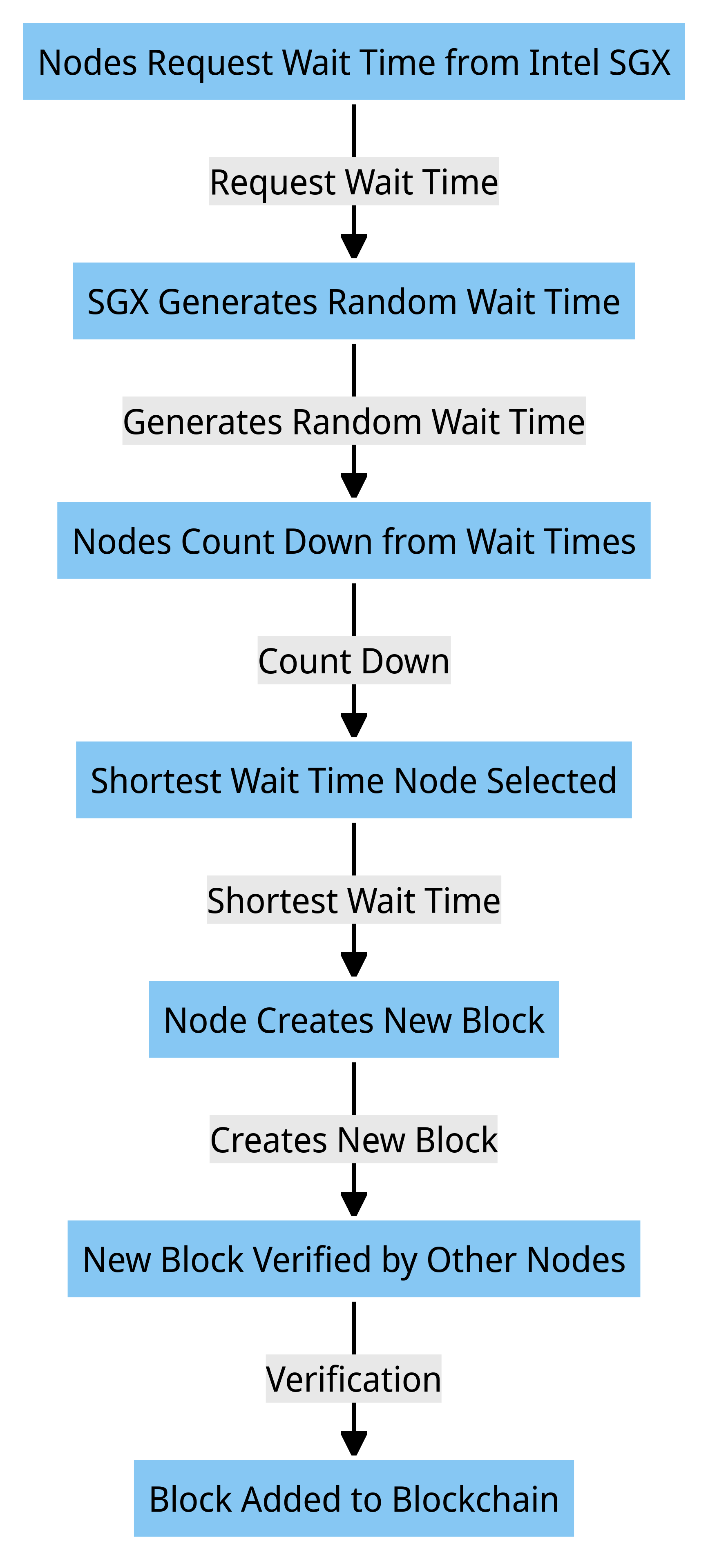Blockchain technology has revolutionized the way we perceive and handle transactions, offering enhanced security, transparency, and efficiency. One of the key factors contributing to the success of blockchain networks is the consensus mechanism. A promising consensus algorithm that has gained significant traction in recent years is Proof of Elapsed Time (PoET).
PoET utilizes a unique approach that offers faster transaction validation, reduced energy consumption, and improved scalability. In this blog section, we will delve into the top blockchains that have adopted PoET for efficient consensus, exploring their features, benefits, and potential impact on various industries.
What is Proof of Elapsed Time (PoET)?
Proof of Elapsed Time (PoET) is a consensus algorithm developed by Intel as an alternative to traditional proof-of-work algorithms like Bitcoin’s PoW. In PoET, instead of solving complex mathematical puzzles, participants in the network are assigned mining rights based on a random wait time. This approach ensures fairness and prevents any single participant from having an advantage over others when it comes to validating transactions and adding new blocks to the blockchain. By implementing this random wait time, PoET aims to achieve efficient consensus while also minimizing energy consumption and maintaining a high level of security. This innovative algorithm is gaining popularity for its ability to address some of the key challenges faced by other blockchain consensus mechanisms.
How does PoET work?
PoET, short for Proof of Elapsed Time, is a consensus algorithm that has gained popularity among several top blockchains. The way it operates is by choosing the next block creator through a random wait time. This means that every participant in the network has an equal chance of being selected to create the next block. The use of a random wait time ensures that no single participant can monopolize the block creation process, promoting a fair and inclusive blockchain ecosystem. This decentralized approach is one of the factors that makes PoET a reliable and efficient consensus mechanism for blockchains.
Here is how Proof of Elapsed Time works, step by step, in detail:
- Each node in the network requests a wait time from Intel SGX. Intel SGX is a trusted hardware component that allows Intel processors to create secure enclaves. These enclaves can be used to protect sensitive data and code from being accessed by unauthorized programs.
- SGX generates a random wait time for each node. This wait time is a positive integer in the range from 0 to a predetermined maximum value.
- Nodes start counting down from their wait times. The node with the shortest wait time is chosen to create the next block.
- The chosen node creates a new block and adds it to the blockchain. The new block will contain new transaction data and information about the previous block.
- Other nodes in the network verify the new block and add it to their own blockchain.

If two or more nodes have the same shortest wait time, then a tie-breaking mechanism is used to determine which node will create the next block. A common tie-breaking mechanism is to use the node’s public key.
Here is an example of how Proof of Elapsed Time works:
Suppose there are 5 nodes in a PoET network. Each node requests a wait time from Intel SGX. SGX returns the following wait times:
- Node 1: 100
- Node 2: 200
- Node 3: 300
- Node 4: 400
- Node 5: 500
Nodes start counting down from their wait times. Node 1 will finish counting down first, so node 1 is chosen to create the next block. Node 1 creates a new block and adds it to the blockchain. Other nodes in the network verify the new block and add it to their own blockchain.
PoET has a number of advantages over other consensus mechanisms, such as Proof of Work (PoW) and Proof of Stake (PoS). PoET is more energy-efficient than PoW because it does not require nodes to solve complex mathematical problems. PoET is also more scalable than PoS because it does not require nodes to stake coins in order to participate in the consensus mechanism.
PoET is still a relatively new consensus mechanism, but it has the potential to be widely adopted in the future. It has already been used in a number of popular blockchains, such as Hyperledger Sawtooth and R3 Corda.

Here are some more specifics regarding the operation of Proof of Elapsed Time:
- Intel SGX: Intel SGX is a security technology that allows Intel processors to create secure enclaves. These enclaves are protected from unauthorized access, including access from the operating system itself. This makes them ideal for use in blockchain applications, where security is important.
- Wait time: Wait time is a positive integer in the range from 0 to a predetermined maximum value. The maximum value is determined by the blockchain network developers.
- Tie-breaking mechanism: A tie-breaking mechanism is used to determine which node will create the next block in the event that two or more nodes have the same shortest wait time. A common tie-breaking mechanism is to use the node’s public key.
What are the advantages of PoET over other consensus mechanisms?
Advantages of the Proof of Elapsed Time (PoET) consensus algorithm. Here’s a summary of these key points:
- Energy Efficiency: PoET eliminates the need for energy-intensive computational tasks, reducing the environmental impact of blockchain networks. This energy efficiency ensures sustainability in the long term, addressing concerns associated with high energy consumption in traditional proof-of-work algorithms.
- Fairness and Inclusivity: PoET’s random selection process ensures that every participant has an equal opportunity to be chosen as the next block validator. This fairness promotes a democratic and inclusive blockchain ecosystem, encouraging active engagement from all network participants.
- Scalability: PoET’s random selection mechanism enables faster transaction validation and network growth, making it highly scalable. This scalability allows PoET-based blockchains to handle larger transaction volumes without compromising speed or network efficiency, making them suitable for various high-throughput applications.
- Security: PoET enhances security by discouraging malicious actors through its random selection process, making it challenging to predict who will validate the next block. This randomness adds an extra layer of protection against attacks, ensuring the integrity and trustworthiness of the blockchain network.
The combination of these factors makes PoET a powerful and attractive consensus algorithm for blockchain networks. Its ability to address energy consumption, promote fairness, ensure scalability, and enhance security positions it as a significant contender in the ongoing evolution of the blockchain ecosystem, with potential applications in various industries.
What are the disadvantages of PoET?
Proof of Elapsed Time (PoET) has its limitations, which must be considered in its implementation:
- Trusted Hardware Requirement: PoET necessitates specialized hardware components, increasing implementation costs and complexity. This requirement might deter organizations with limited resources or technical expertise from adopting PoET-based blockchains.
- Assumption of Honest Behavior: PoET relies on the assumption that all participants will behave honestly. If a participant attempts to cheat or manipulate the system, the blockchain’s integrity can be compromised, making the network vulnerable.
- Susceptibility to Attacks: PoET can be susceptible to certain attacks, including time-based attacks and collusion between participants. Manipulating wait times or insider collusion can lead to unfair advantages, compromising the fairness and integrity of the PoET consensus mechanism.
- Scalability Challenges: PoET’s scalability can be an issue in large blockchain networks with a high volume of transactions. Participants must wait for their turn to generate blocks based on elapsed time, potentially slowing down transaction processing. This delay affects the overall speed and efficiency of the blockchain, making it less suitable for applications requiring rapid transaction validation and high throughput.
While these challenges exist, it’s essential to note that ongoing research and advancements in blockchain technology aim to address these limitations. Additional security measures and optimizations can mitigate these vulnerabilities. Despite its drawbacks, PoET offers significant advantages in terms of energy efficiency, fairness, and security, making it a valuable consensus algorithm. As technology continues to progress, these limitations are likely to be overcome, enhancing the effectiveness and reliability of PoET in the future.
What blockchains use PoET?
Several prominent blockchain platforms have successfully implemented Proof of Elapsed Time (PoET) for efficient consensus, including Hyperledger Sawtooth, R3 Corda, Quorum, and Credits.
- Hyperledger Sawtooth is an open-source blockchain platform renowned for its scalability and energy efficiency. By utilizing PoET, Sawtooth ensures fairness and inclusivity by giving every participant an equal chance to create the next block. This approach allows Hyperledger Sawtooth to handle high transaction volumes while maintaining efficiency and security.
- R3 Corda is a distributed ledger technology platform that employs PoET to achieve consensus among network participants while preserving high performance and privacy. PoET’s fair and random block creation process prevents any single participant from monopolizing the system, promoting inclusivity and enhancing security. This decentralized approach enables fast transaction processing, making R3 Corda suitable for real-time validation and high throughput applications.
- Quorum, developed by JPMorgan Chase, is an enterprise-focused blockchain platform that utilizes PoET for fast transaction processing and secure consensus. PoET ensures fair block creation, fostering trust and integrity within the Quorum network. This implementation enables Quorum to handle a large number of transactions without compromising speed or security, making it an excellent choice for businesses seeking an efficient, scalable, and reliable blockchain solution.
- Credits is another blockchain platform that employs PoET for consensus. While the specific details about its implementation are not provided in the given text, it likely utilizes PoET’s fairness and energy efficiency features to enhance its blockchain’s overall performance and reliability.
Challenges and Future Developments
Challenges faced by PoET-based blockchains
Challenges faced by PoET-based blockchains. Let’s recap these challenges and potential solutions:
- Scalability: The increase in transaction volume can slow down PoET-based blockchains. Solutions like sharding and layer-two protocols are being explored to enhance overall throughput, allowing parallel processing of transactions and improving scalability.
- Reliance on Trusted Hardware: PoET’s dependence on Trusted Execution Environments (TEEs) poses security risks. Ensuring the integrity of hardware components is essential to mitigate these risks, requiring collaboration between hardware manufacturers and blockchain developers to establish robust security measures.
- Privacy Concerns: PoET itself doesn’t provide privacy guarantees, necessitating additional measures such as zero-knowledge proofs and secure multi-party computation. These technologies enable confidential data processing, ensuring sensitive information remains private while still allowing for efficient consensus.
- Lack of Dynamic Participation: PoET’s lack of dynamic participation hampers network resilience and flexibility. Allowing nodes to enter and exit the consensus process dynamically would enhance usability and efficiency, adapt to changing network conditions, and accommodate nodes with varying resources.
Addressing these challenges and continuously exploring innovative solutions will be essential in maximizing the potential of PoET-based blockchains. As technology advances, these improvements will play a crucial role in enhancing the efficiency, security, and usability of PoET as a consensus mechanism in diverse blockchain applications.
Future developments and potential enhancements to PoET
Key strategies aimed at improving the performance, security, and scalability of Proof of Elapsed Time (PoET) based blockchains. The following is a concise overview:
- Scalability Solutions (Sharding, Sidechains): Dividing the blockchain into smaller sections or utilizing secondary chains improves overall throughput, allowing PoET-based blockchains to handle higher transaction volumes without sacrificing efficiency.
- Alternative Trusted Hardware and Cryptographic Techniques: Exploring secure hardware components and advanced cryptographic protocols enhances blockchain security. Tamper-resistant hardware and robust cryptographic methods safeguard the consensus process, preventing attacks and ensuring the integrity of PoET-based blockchains.
- Privacy-Preserving Technologies (Zero-Knowledge Proofs): Implementing privacy-preserving technologies like zero-knowledge proofs protects data confidentiality. These techniques enable selective disclosure of information while maintaining data integrity, ensuring sensitive data remains secure on the blockchain.
- Dynamic Participation Mechanisms: Allowing nodes to enter and exit the consensus process dynamically enhances network adaptability and resilience. This flexibility accommodates nodes with varying resources, improving the overall efficiency and usability of PoET-based blockchains.
By incorporating these advancements, PoET-based blockchains can overcome existing challenges, becoming more efficient, secure, and adaptable. These strategies represent crucial steps toward realizing the full potential of PoET in diverse applications.
PoET vs. Proof of Work (PoW)
PoET is a more energy-efficient and scalable consensus mechanism than PoW. It does not require nodes to solve complex mathematical problems, which can be computationally expensive and requires a lot of energy. Instead, PoET uses a lottery system to determine which node gets to create the next block. Each node is assigned a random wait time, and the node with the shortest wait time wins the lottery and gets to create the next block.
PoW is a less energy-efficient and scalable consensus mechanism than PoET. It requires nodes to solve complex mathematical problems in order to create new blocks. This can be very computationally expensive and requires a lot of energy. However, PoW is also a more secure consensus mechanism than PoET. It is more difficult for malicious actors to attack a PoW network because they would need to control a majority of the computing power on the network.
Here is a table that summarizes the key differences between PoET and PoW:
| Characteristic | PoET | PoW |
|---|---|---|
| Energy efficiency | More energy-efficient | Less energy-efficient |
| Scalability | More scalable | Less scalable |
| Security | Less secure | More secure |
Which consensus mechanism is better?
It depends on the specific needs of the blockchain network. If energy efficiency and scalability are important factors, then PoET is a good choice. If security is the most important factor, then PoW is a better choice.
PoET vs. Proof of Stake (PoS)
PoET is a more energy-efficient and scalable consensus mechanism than PoS. It does not require nodes to stake coins in order to participate in the consensus mechanism, which can be a barrier to entry for new nodes. Instead, PoET uses a lottery system to determine which node gets to create the next block. Each node is assigned a random wait time, and the node with the shortest wait time wins the lottery and gets to create the next block.
PoS is a more secure consensus mechanism than PoET. It is more difficult for malicious actors to attack a PoS network because they would need to control a majority of the staked coins on the network. However, PoS can be less scalable than PoET, especially if the staking requirements are high.
Here is a table that summarizes the key differences between PoET and PoS:
| Characteristic | PoET | PoS |
|---|---|---|
| Energy efficiency | More energy-efficient | Less energy-efficient |
| Scalability | More scalable | Less scalable |
| Security | Less secure | More secure |
Which consensus mechanism is better?
It depends on the specific needs of the blockchain network. If energy efficiency and scalability are important factors, then PoET is a good choice. If security is the most important factor, then PoS is a better choice.
Conclusion
The Proof of Elapsed Time (PoET) consensus mechanism is a secure and efficient method for validating blockchain transactions without excessive energy consumption. It has been successfully implemented in prominent blockchains like Intel’s Hyperledger Sawtooth and R3 Corda, and its reliability is gaining confidence among industry leaders.
PoET’s future in blockchain technology is promising due to its scalability and minimal energy requirements. Research is ongoing to improve its performance and security, expanding its applications to areas like supply chain management and healthcare records. Despite its dependence on trusted hardware, alternative solutions are being developed to make PoET accessible in various settings. Collaboration among academia, industry professionals, and blockchain communities is crucial for addressing security vulnerabilities and improving PoET’s resilience.
FAQs
What is Proof of Elapsed Time (PoET)?
Proof of Elapsed Time (PoET) is a consensus mechanism used in blockchain networks. It operates on the principle of a fair lottery system, where each participating node generates a random wait time. The node with the shortest wait time is selected to create a new block, ensuring fairness and efficiency in the consensus process.
How does PoET differ from traditional consensus mechanisms like Proof of Work (PoW)?
Unlike Proof of Work, which requires significant computational power and energy consumption, PoET is energy-efficient. PoET’s random wait time approach ensures that no single node has an advantage, making it a sustainable and fair choice for blockchain applications.
What are the key advantages of PoET in blockchain networks?
PoET offers several advantages, including energy efficiency, fairness, and scalability. Its minimal energy consumption makes it environmentally friendly, while the fair lottery system ensures equal opportunities for all nodes, promoting a level playing field in the network.
In which industries can PoET be applied?
PoET’s applications extend beyond cryptocurrency. It can be used in various industries such as supply chain management, logistics, inventory management, and any sector where transparent and secure record-keeping is essential.
Is PoET vulnerable to any security risks?
While PoET is designed to be secure, like any technology, it is not completely immune to vulnerabilities. Ongoing research and development efforts are focused on addressing potential security challenges, ensuring PoET’s resilience in diverse network environments.







